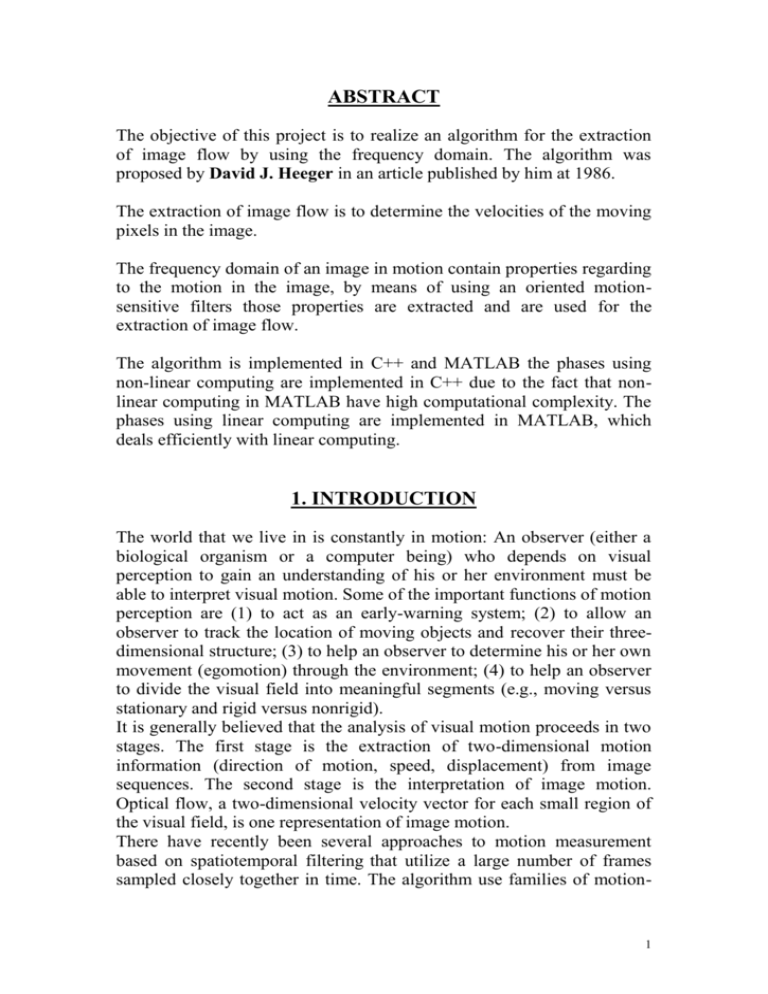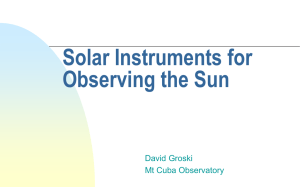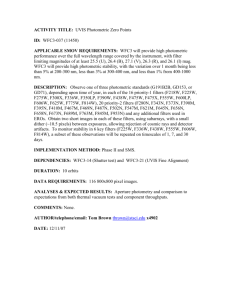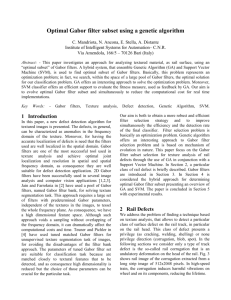proje
advertisement

ABSTRACT The objective of this project is to realize an algorithm for the extraction of image flow by using the frequency domain. The algorithm was proposed by David J. Heeger in an article published by him at 1986. The extraction of image flow is to determine the velocities of the moving pixels in the image. The frequency domain of an image in motion contain properties regarding to the motion in the image, by means of using an oriented motionsensitive filters those properties are extracted and are used for the extraction of image flow. The algorithm is implemented in C++ and MATLAB the phases using non-linear computing are implemented in C++ due to the fact that nonlinear computing in MATLAB have high computational complexity. The phases using linear computing are implemented in MATLAB, which deals efficiently with linear computing. 1. INTRODUCTION The world that we live in is constantly in motion: An observer (either a biological organism or a computer being) who depends on visual perception to gain an understanding of his or her environment must be able to interpret visual motion. Some of the important functions of motion perception are (1) to act as an early-warning system; (2) to allow an observer to track the location of moving objects and recover their threedimensional structure; (3) to help an observer to determine his or her own movement (egomotion) through the environment; (4) to help an observer to divide the visual field into meaningful segments (e.g., moving versus stationary and rigid versus nonrigid). It is generally believed that the analysis of visual motion proceeds in two stages. The first stage is the extraction of two-dimensional motion information (direction of motion, speed, displacement) from image sequences. The second stage is the interpretation of image motion. Optical flow, a two-dimensional velocity vector for each small region of the visual field, is one representation of image motion. There have recently been several approaches to motion measurement based on spatiotemporal filtering that utilize a large number of frames sampled closely together in time. The algorithm use families of motion- 1 sensitive mechanisms, each of which is selective for motion in different directions. 2. MOTION IN THE FREQUENCY DOMAIN Previous studies have pointed out that some properties of image motion are most evident in the Fourier domain. A. One-Dimensional Motion The spatial frequency of a moving sine wave is expressed n cycles per unit of distance (e.g., cycles per pixel) and its temporal frequency is expressed in cycles per unit of time (e.g., cycles per frame). Velocity, which is distance over time or pixels per frame, equals the temporal frequency divided by the spatial frequency: V = t/x When a signal is sampled evenly in time, frequency components greater than the Nyquist frequency (1/2 cycle per frame) become undersampled, or aliased. As a consequence, if a sine-wave pattern is shifted more than half of its period from frame to frame, it will appear to move in the opposite direction. For example, a sine wave with a spatial frequency of 1/2 cycle per pixel can have a maximum velocity of one pixel per frame, and a sine wave with a spatial frequency of 1/4 cycle per pixel can have a maximum velocity of two pixels per frame; in other words, the range of possible velocities of a moving sine wave is limited by its spatial frequency. Now consider a one-dimensional signal, moving with a given velocity v, that has many spatial-frequency components. Each such component x has a temporal frequency of t1 = vx1 while each spatial-frequency component 2x has twice the temporal frequency. In fact, the temporal frequency of this moving signal as a function of its spatial frequency is a straight line passing through the origin, where the slope of the line is V. B. Two-Dimensional Motion Analogously, two-dimensional patterns (textures) translating in the image plane occupy a plane in the spatiotemporal frequency domain: t = ux + vy 2 where V = ( u , v ) is the velocity of the pattern. For example, the expected value of the power spectrum of a translating random-dot field is a constant within this plane and zero outside it. If the motion of a small region of an image maybe approximated by translation in the image plane, the velocity of the region may be computed in the Fourier domain by finding the plane in which all the power resides. To extract optical flow we could take small spatiotemporal windows out of the image sequence and fit a plane to each of their power spectra. The algorithm estimate velocity by using motion-sensitive spatiotemporal Gabor-energy filters to sample these power spectra efficiently. The Fourier transform support of an image moving in a given velocity V 3 3. MOTION-SENSETIVE FILTERS Previous studies have shown that motion is like orientation in space-time, and spatiotemporally oriented filters can be used to detect it. Threedimensional (3D) Gabor energy filters are such oriented spatiotemporal filters. 1st. 3D Gabor Energy Filters a 3D gabor filter is: x2 y2 t 2 X g(x,y,t) = exp 2 2 2 2 3 2 x y t 2 y 2 t 2 x sin 2x 0 x 2 y 0 y 2t 0 t 1 where ( y0 t0 x0 ) is the center frequency ( the spatial and temporal frequency for which this filter gives its greatest output ). The frequency response of such a Gabor energy filter is the sum of pair of 3D Gaussians: G(x , y , t ) = 1 exp 4 2 x 2 ( x x 0 ) 2 y 2 ( y y 0 ) 2 t 2 ( t t 0 ) 2 4 1 + exp 4 2 x 2 ( x x 0 ) 2 y 2 ( y y 0 ) 2 t 2 ( t t 0 ) 2 4 This equation means that motion energy filter with center frequency ( y0 t0 x0 ) will give a large output for a stimulus that as a great deal of power near the filter’s center frequency and will give a smaller output for a stimulus that as little power near the filter’s center frequency. 2nd. A Family of Motion-Energy Filters The algorithm uses a family of Gabor-energy filters, all of which are tuned to the same spatial-frequency band but to different spatial orientations and temporal frequencies. Eight of the twelve energy filters used in the present implementation have their peak response for patterns moving in a given direction-for example, one of them is most sensitive to rightward motion of vertically oriented patterns, while another is most sensitive to leftward motion. The other four filters have their peak response for stationary patterns, each with a different spatial orientation. 4 The power spectra of the 12 motion-sensitive Gabor-energy filters are positioned in pairs on a cylinder in the spatiotemporal frequency domain. Each symmetrically positioned pair of ellipsoids represents the power spectrum of one filter. The plane represents the power spectrum of a translating texture. A filter will give a large output only for a stimulus that has much power near the centers of its corresponding ellipsoids, and it will give a relatively small output only for a stimulus that has no power near the centers of its ellipsoids. Each velocity corresponds to a different tilt of the plane and thus to a different distribution of outputs for the collection of motion-energy mechanisms. 4. MOTION ENERGY TO EXTRACT IMAGE FLOW Parseval's theorem may be used to derive an equation that predicts the output of a Gabor-energy filter in response to a moving random texture. The expected value of the power spectrum of a translating random-dot field is zero, except within a plane t = ux + vy where it is a constant k. By Parseval's theorem, gabor energy in response to a moving-random texture is: Ri(u,v) = exp [ 4 2 2 x y t 2 2 (u x 0 v y 0 t 0 ) 2 (u x t ) 2 (v y t ) 2 ( x y ) 2 ] 1 < i < 12 We convolve the input image sequence with 12 gabor filters and compute for each filter its output energy, mi. The image flow will be extracted by minimizing the difference between the predicted and measured motion energies. Let Ri be the predicted motion energies for a family of filters: each i corresponds to a filter with a different center frequency. Let mi be the observed motion energies-the outputs of that family of filters. Let m1 be the sum of the outputs of those filters that have the same preferred spatial orientation as the ith filter, and let R1 be the corresponding sum of the predicted motion energies. 5 A least-squares estimate of V= ( u , v ) minimizes: f (u, v) mi Ri (u, v) mi Ri (u, v) i 1 12 2 There are standard numerical methods for minimizing for example the Gauss-Newton gradient descent method. 6








